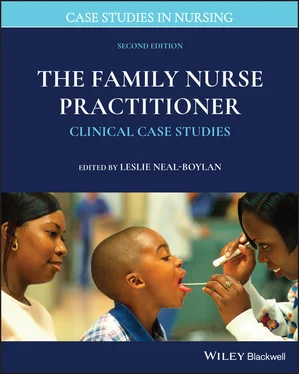5 Are any referrals needed?
6 Are there any demographic characteristics that would affect this case?
7 Are there any standardized guidelines that should be used to assess or treat this case?
By Mikki Meadows‐Oliver, PhD, RN, FAA
Matthew, a 27‐day‐old infant, arrives at the office with complaints of “breathing fast” and congestion since yesterday. He is accompanied by both parents. He has had no fever. At home, his rectal temperature was 37.2 degrees this morning. The parents tried using a humidifier to alleviate the symptoms, but they do not feel that this helped. They also used a bulb syringe with nasal saline to help relieve nasal congestion. Matthew has had several visitors at his home during the first few weeks of his life, including small children who attend day‐care centers. His mother thinks that some of those visitors may have had cold symptoms, although she tried to keep anyone who seemed sick away from Matthew.
Diet:Normally breastfeeding every 2–3 hours; occasionally supplementing with a milk‐based formula. Since yesterday, intake has decreased.
Elimination:4–6 wet diapers since yesterday, which is decreased from his normal urine output. 2–3 bowel movements.
Sleep:Normally sleeps approximately 5 hours at night with several naps throughout the day. However, since yesterday, Matthew’s sleep has been interrupted.
Medications:Currently taking no prescription, herbal, or over‐the‐counter medications.
Allergies:No known allergies to food, medications, or environment.
Birth history:Matthew was the product of a 39‐week gestation. He was delivered via planned cesarean section. Matthew’s mother had no falls or known exposures to environmental hazards. She has a history of chlamydia during the pregnancy at 36 weeks’ gestation. She was treated with antibiotics. The only other prescription medications taken during the pregnancy were prenatal vitamins. She did not use tobacco products or use illicit drugs. She stated that she drank an occasional glass of wine during the third trimester. Matthew’s birth weight was 3250 g, and his Apgar scores were 9 at 1 minute and 9 at 5 minutes.
Social history:Matthew was born to a 32‐year‐old mother. He lives at home with both parents. Neither parent has any other children. The mother works as a secretary, and the father works in construction. Matthew’s father is a smoker. The family has 2 cats.
Family medical history:PGF (age 65): Type 2 diabetes mellitus; PGM (age 64): breast cancer at age 55; MGF (age 60): asthma; MGM (age 64): healthy; mother (age 32): asthma; father (age 32): seasonal allergies.
Vital signs:Weight: 4050 grams; length: 48 cm; temperature: 37.2°C (rectal); pulse oximeter reading: 91% on room air.
General:Alert, well‐hydrated, well‐nourished baby in mild respiratory distress.
Skin:Clear with no lesions noted; no cyanosis of skin, lips, or nails; no diaphoresis noted; good skin turgor.
Head:Normocephalic; anterior fontanelle open and flat (2 cm × 2 cm); posterior fontanelle open and flat (0.5 cm × 0.5 cm).
Eyes:Red reflex present bilaterally; pupils equal, round, and reactive to light; no discharge noted.
Ears:Pinnae normal; tympanic membranes gray bilaterally with positive light reflex.
Nose:Both nostrils congested; cloudy discharge present in nares; mild nasal flaring.
Oropharynx:Mucous membranes moist; no teeth present; no lesions.
Neck:Supple; no nodes.
Respiratory:RR = 42; expiratory wheezing present in all lobes; intercostal retractions present; no grunting; no deformities of the thoracic cage noted.
Cardiac/Peripheral vascular:HR = 120; regular rhythm; no murmur noted; brachial and femoral pulses present and 2+ bilaterally.
Abdomen/Gastrointestinal:Soft, nontender, nondistended, no evidence of hepatosplenomegaly.
Genitourinary:Normal male genitalia; testes descended bilaterally.
Back:Spine straight.
Extremities:Full range of motion of all extremities; warm and well‐perfused; capillary refill <2 seconds; negative hip click.
Neurologic:Good suck and cry; good tone in all extremities; positive Moro, rooting, plantar, palmar, and Babinski reflexes.
1 Which diagnostic or imaging studies should be considered to assist with or confirm the diagnosis?___Chest radiograph (anterior‐posterior [AP] and lateral views)___Nasopharyngeal swab to detect respiratory syncytial virus (RSV)___Complete blood count
2 What is the most likely differential diagnosis and why?___Bronchiolitis___Upper respiratory infection (URI)___Chlamydial pneumonia
3 What is the plan of treatment, referral, and follow‐up care?
4 What demographic characteristics might affect this case?
5 Does the patient’s psychosocial history impact how you might treat him?
6 What if the patient lived in a rural, isolated setting?
Case 1.5 Nutrition and Weight
By Mikki Meadows‐Oliver, PhD, RN, FAAN
Anita is a 2‐week‐old Hispanic female in for her well‐child check. She is accompanied by her 15‐year‐old mother. The family speaks only Spanish. A Spanish‐speaking interpreter is used for the visit. Anita’s mother is concerned that Anita spits up a lot after eating. The mother states that the vomit is not projectile. The mother is worried that, since the baby is vomiting so much, she is not getting enough food. Therefore, the mother has been feeding Anita even more formula. Also, Anita’s mother is worried that she will run out of formula since the baby takes so much.
Diet:Formula feeding: 5 oz every 2–3 hours.
Elimination:6 wet diapers and 3 bowel movements since yesterday.
Sleep:Sleeps approximately 4 hours at night with several naps throughout the day.
Medications:Currently taking no prescription, herbal, or over‐the‐counter medications.
Allergies:No known allergies to food, medications, environment.
Birth history:Anita was the product of a 38‐week gestation. She was delivered via spontaneous vaginal delivery. Anita’s mother had no falls, infections, or known exposures to environmental hazards. The only prescription medications taken during the pregnancy were prenatal vitamins. She did not use alcohol, tobacco products, or illicit drugs during the pregnancy. Anita’s birth weight was 3250 g and her Apgar scores were 8 at 1 minute and 9 at 5 minutes. Her discharge weight was 3180 g.
Social history:Anita lives at home with her teenage mother and her maternal grandmother (MGM), who emigrated from Mexico. The father of the baby is involved. Neither parent has any other children. Both parents are students at a local high school. The family has a dog.
Family medical history:PGF (age 37): high blood pressure; PGM (age 33): thyroid problems; MGF (age 35): health history unknown; MGM (age 30): healthy; mother (age 15): healthy; father (age 15): healthy.
Vital signs:Weight: 4050 g; length: 48 cm; temperature: 37.3°C (rectal).
General:Alert, well‐developed baby.
Читать дальше












